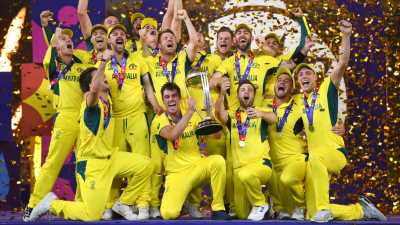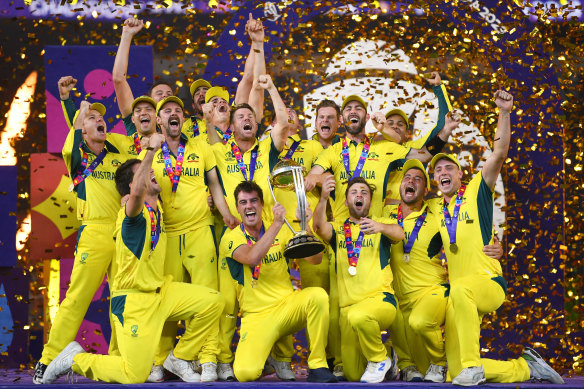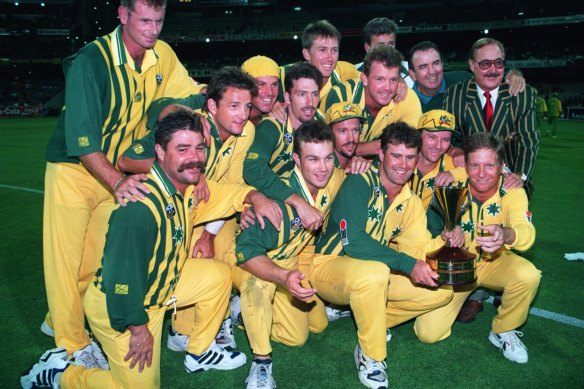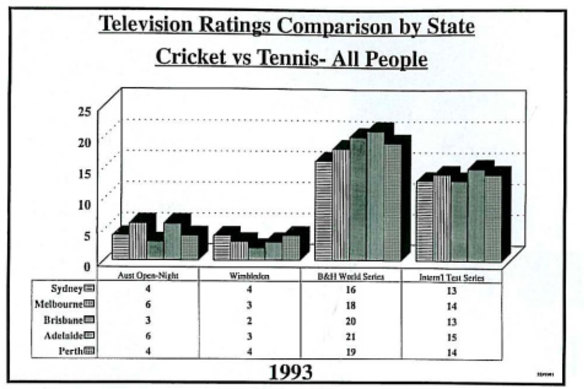
Save articles for later
Add articles to your saved list and come back to them any time.
Cricket’s greatest obstacle is not an outdated format. It is the proliferation of meaningless matches in any form.
One-day cricket was seen, in the lead-up to the World Cup, as the problem area for the game. Lacking the longevity of Tests or the frisson of Twenty20, ODI games appeared to be caught hopelessly in the middle – or so the perceptions were.
Hard earned: Australia celebrate their World Cup victory.Credit: Getty
But if Australia’s World Cup victory in Ahmedabad proved anything other than the greatness of the current team, it was that 50-over cricket has many enduring virtues, provided it is played in matches with genuine meaning.
As he often does, captain Pat Cummins distilled the value of the cup win beautifully in the moments after accepting the trophy from India’s nonplussed Prime Minister, Narendra Modi.
“Every international team comes together,” Cummins said. “You only get a shot at it every four years. Even if you have a 10-year career, you might only get two chances at it. The whole cricket world stops with this World Cup. So it doesn’t get any better.”
Cummins’ generation, and those of the other competing teams, grew up watching 50-over games at World Cups and elsewhere. For that reason, it was telling to hear Cummins speak of the challenge they provide with the sort of affection once used exclusively by players when talking about Tests.
This is not just nostalgia. It comes from the same place as the admiration for Tests, namely in terms of how the format pushes players and identifies the best practitioners. Tests do so more readily than ODIs, but ODIs are also truer indicators than T20.
The physicality and mental strength of players is tested by a one-day game: Greg Chappell and Aaron Finch are two former captains who have each said they sapped more energy than other forms. Australia’s committed fielding across 50 overs, at the end of such a long year of overseas trials, was as clear a marker of champion status as batting or bowling.
It is also harder to “hide” in ODI matches. The allocation of 10 overs to each bowler allows for multiple spells of varying rhythms, and batters need to be able to play at more than one speed. Two of the best knocks of the cup were by Travis Head in the final, but also by South Africa’s David Miller in the semi. Each had to absorb pressure before returning fire.
Thirdly, the history of ODIs provides a genuine marker point for successive generations to prove themselves. Head joined Clive Lloyd, Viv Richards, Aravinda de Silva, Ricky Ponting and Adam Gilchrist as centurions in a men’s World Cup final.
Australia celebrate their 2-0 victory over Australia A in the 1995 quad series final.Credit: Getty
If Ponting and Gilchrist were both proven great players by the time they made their bows, Head’s career arc is closer in line with Lloyd, Richards or de Silva. Spectators at Lord’s in 1975 and 1979, then Lahore in 1996, did not yet know how good they might become, but the finals provided a fairly good idea.
All that said, the problem for all of cricket’s formats lies in the space between big events. The game’s economy is largely run from the broadcast money reaped by bilateral events. In most cases, it comes down to how often India tour another country and what that tour is worth to the hosts.
Australia’s current T20 series in India is an obligatory one for Cricket Australia to pay back India for playing matches on these shores. But there is no meaning whatsoever to the games beyond the broadcast arithmetic.
Similarly, the white-ball series to be played against the West Indies – who failed to qualify for the World Cup – in February will have very little contextual resonance, even though the games are still valuable in terms of CA’s broadcast deal with Foxtel. Bilateral ODI matches have been paywalled in Australia since 2018, further limiting their audience size.
Context is not necessarily a new issue. Many will point to the “golden era” of white-ball games where the World Series Cup dominated every January: Michael Bevan’s night of nights in Sydney in 1996 stands as the single most indelible memory. White-ball triangular series also filled stadiums from Sharjah to Singapore.
But don’t forget that those series were the epicentre of cricket’s match-fixing epidemic in the 1990s – a scandal that really could have put world cricket on its knees through the loss of credibility. Meaningless games make for all manner of troubles.
Last week, CA’s chief executive Nick Hockley and chair Mike Baird went to India with the goal of regenerating discussion about reinstating an ODI league between World Cups, turning those series into qualifying matches with wider context.
The ratings were in: From the Australian Cricket Board’s annual report in 1993-94.
At the same time, the BCCI remade the case to stick with the current 10-team format for the World Cup. Ostensibly this is because it will mean more guaranteed matches for India, and therefore more broadcast rights value for the International Cricket Council’s main rights holders Star Sports, soon to be sold by Disney to Mukesh Ambani’s Reliance Industries.
But in the exhausted satisfaction of Cummins and company, another argument could be made for its retention. Unlike in other cup formats, Australia had been forced to play, and beat, every team in the tournament to win the trophy.
To do so successfully provided a reminder that ODI cricket is not the problem child many around the game have perceived. Just keep it meaningful, and the game played over 100 overs in a single day can have a future just as long as Test matches.
News, results and expert analysis from the weekend of sport sent every Monday. Sign up for our Sport newsletter.
Most Viewed in Sport
From our partners
Source: Read Full Article


